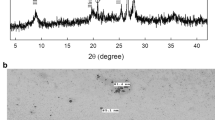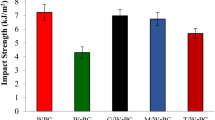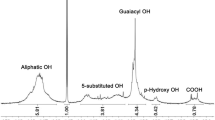Abstract
Hard wood–polymer composite (HWC) was prepared, based on hot press technique, by mixing air-dried rice straw waste as a filler into a molten of chemically recycled extended polystyrene foam waste (PS) and its maleated form (PS-g-MA) as a matrix. Two fire retardants (FRs), namely zinc borate (ZB) and/or anhydrous magnesium hydroxide (MH), were dispersed into the composite to compensate for the poor thermal stability and flammability of the composite. Thermal properties of the reached HWC were evaluated by different techniques including thermogravimetric analysis, differential scanning calorimetric, in addition to, flammability analyses. Mechanical characterization was, also, rated based on tensile strength and elongation at break measurements. It was found that incorporation of the nominated fire retardants improved the thermal stability of the final products. Besides, flammability resistance was enhanced as ZB and/or MH was added to the hard wood–polymer composite formulation. The onset temperature of degradation and mass loss rates were significantly reduced in the presence of the FRs. The tensile strength of HWC was reinforced by marked additions of the FRs. The obtained data can fulfill the required optimal performance of the HWC to fire and mechanical characterizations which are necessary for many applications in the residential construction, transportation and furniture industries.




Similar content being viewed by others
References
Nikolaeva M, Karki T. A review of fire retardant processes and chemistry with discussion of the case of wood–plastic composites. Baltic For. 2011;17:314–26.
Kim JK, Pal K. Recent advances in the processing of wood–plastic composites. In: Engineering materials, flammability in WPC composites, vol. 32. Berlin: Springer; 2010. p. 129. https://doi.org/10.1007/978-3-642-14877-4_6.
Paukszta D, Borysiak S. The Influence of processing and the polymorphism of lignocellulosic fillers on the structure and properties of composite materials—a review. Materials. 2013;6:2747–67.
Salasinska K, Borucka M, Leszczyńska M, Zatorski W, Celiński M, Gajek A, Ryszkowska J. Analysis of flammability and smoke emission of rigid polyurethane foams modified with nanoparticles and halogen-free fire retardants. J Therm Anal Calorim. 2017;130:131–41.
Hirschler MM. Safety, health and environmental aspects of flame retardants, Chapter 6. In: Selcen Kilinc-Balci F, editor. Handbook of fire resistant textiles. Woodhead Publishing Limited; 2013. p. 108–73. https://doi.org/10.1533/9780857098931.1.108.
Tawfik ME, Eskander SB, Nawwar GAM. Hard wood-composites made of rice straw and recycled polystyrene foam wastes. J Appl Polym Sci. 2017. https://doi.org/10.1002/app.44770.
Abdullah NM, Ahmad I. Fire-retardant polyester composites from recycled polyethylene terephthalate (PET) wastes reinforced with coconut fibre. Sains Malays. 2013;42:811–8.
Buzarovska A, Bogoeva-Gaceva G, Grozdanov A, Avella M, Gentile G, Errico M. Potential use of rice straw as filler in eco-composite materials. Aust J Crop Sci. 2008;1:37–42.
Arao Y, Nakamura S, Tomita Y, Takakuwa K, Umemura T, Tanaka T. Improvement on fire retardancy of wood flour/polypropylene composite using various fire retardants. Polym Degrad Stab. 2014;100:79–85.
Poletto M, Zattera AJ, Forte MMC, Santana RMC. Thermal decomposition of wood: influence of wood components and cellulose crystallite size. Bioresour Technol. 2012;109:148–53.
Durkin DP, Gallagher MJ, Frank BP, Knowlton ED, Trulove PC, Fairbrother DH, Fox DM. Phosphorus-functionalized multi-wall carbon nanotubes as flame-retardant additives for polystyrene and poly(methyl methacrylate). J Therm Anal Calorim. 2017;130:735–53.
Ndlovu SS. Wood–polymer composites utilizing degraded polyolefins as compatibilizers. MSC. Department of Chemistry, Faculty of Natural and Agricultural Sciences, University of the Free State, Qwaqwa Campus; 2011.
Friedrich K, Breuer U. Multi-functionality of polymer composites: challenges and new solutions. Amsterdam: Elsevier; 2015. p. 122. ISBN:978-0-323-26434-1.
Monteiro SN, Calado V, Rodriguez RJS, Margem FM. Thermogravimetric stability of polymer composites reinforced with less common lignocellulosic fibers—an overview. J Mater Res Technol. 2012;1:117–26.
De Chirico A, Armanini M, Chini P, Cioccolo G, Provasoli F, Audisio G. Flame retardants for polypropylene based on Lignin. Polym Degrad Stab. 2003;79:139–45.
Sain M, Park SH, Suhara F, Law S. Flame retardant and mechanical properties of natural fibre–PP composites containing magnesium hydroxide. Polym Degrad Stab. 2004;83:363–7.
Rothon RN, Hornsby PR. Flame retardant effects of magnesium hydroxide. Polym Degrad Stab. 1996;54:383–5.
Sanchez-Olivares G, Sanchez-Soils A, Calderas F, Medina-Torres L, Herrera-Valencia EE, Castro-Aranda JI, Manero O, Di Blasio A, Alongi J. Flame retardant high density polyethylene optimized by on-line ultrasound extrusion. Polym Degrad Stab. 2013;98:2153–60.
Sun L, Wu Q, Xie Y, Wang F, Wang Q. Thermal degradation and flammability properties of multilayer structured wood fiber and polypropylene composites with fire retardants. RSC Adv. 2016;6:13890–7.
Van Krevelen DW. Properties of polymers. 3rd ed. Amsterdam: Elsevier; 1990.
Parida S, Panda M, Parija A, Das SC. Thermal studies of different agrowaste reinforced novolac composites prepared under isothermal conditions. Res J Pharm Biol Chem Sci. 2014;5:1580–92.
Chigwada G, Kandare E, Wang D, Majoni S, Mlambo D, Wilkie CA, Hossenlopp JM. Thermal stability and degradation kinetics of polystyrene/organically-modified montmorillonite nanocomposites. J Nanosci Nanotechnol. 2008;8:1927–36.
Walter DM, Wajer MT. Overview of flame retardants including magnesium hydroxide. Martin Marietta Magnesia Specialties, LLC. 2015. http://www.magnesiaspecialtes.com.
Kaynak C, Ozkaraca AC. Use of zinc borate as the third component of a traditional brominated flame retardant system in acrylonitrile butadiene styrene. Fire Mater. 2013;37:491–502.
Acknowledgements
The authors express their cordial thanks to the Administration of the National Research Centre, Egypt, for providing funding and facilities to carry out this work (Grant No. 10130203).
Author information
Authors and Affiliations
Corresponding author
Rights and permissions
About this article
Cite this article
Eskander, S.B., Tawfik, M.E. & Tawfic, M.L. Mechanical, flammability and thermal degradation characteristics of rice straw fiber-recycled polystyrene foam hard wood composites incorporating fire retardants. J Therm Anal Calorim 132, 1115–1124 (2018). https://doi.org/10.1007/s10973-018-6984-6
Received:
Accepted:
Published:
Issue Date:
DOI: https://doi.org/10.1007/s10973-018-6984-6




